Nowadays, everyone wants to know about succulents. These are easy to grow and drought-resistant desert plants that need little care and maintenance. Succulents can adapt to every adverse environment. Not only green succulents but many colorful types of succulents exist worldwide, such as red succulents.
Red succulents are the most popular fairytale plants. Adding these bold red succulents to green gardens creates terrifically sensational scenes.
Red succulents thrive both indoors and outdoors like other succulents. A wide variety of red succulents possess unique features and grow very fast. These red species can happily thrive with a small amount of soil and water anywhere. People enjoy growing red succulents around them due to their attractive fairytale views.
Be a part of creativity and makeover your best places with our 30 vibrant types of red succulents for indoor and outdoor gardens.
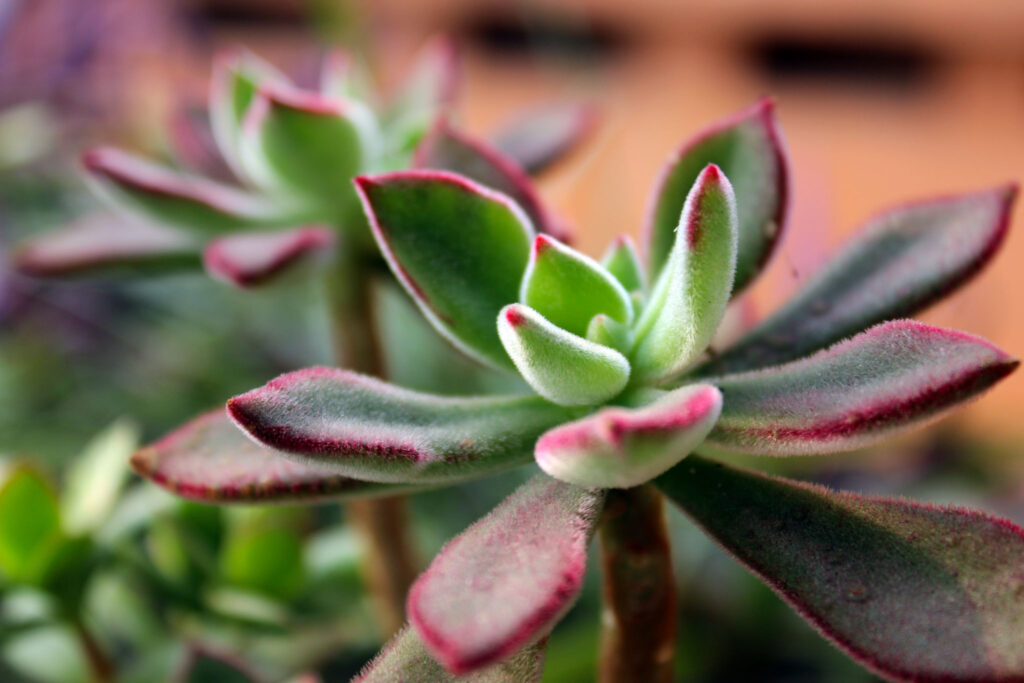
Kingdom: Plantae
Type: Perennial succulent plants
Sunlight: Full direct light or indirect light
Soil: Humus-rich less soil
Water Need: Less water or follow wet and dry method
Hardiness Zone: 2 to 12
Optimal Temperature: 40 to 80 degrees Fahrenheit
Plant Color: Red
Best Growing Places: Both indoors and outdoors
Growing Season: Spring or early summer
Adromischus alstonii
These Adromischus species grow in Western-South Africa and Witpiitz. The plant body consists of 0.15 m long, prostrate, and branched stems. Leaves may be spherical or oval, about 7 cm long, with horny edges.
Deep red spots occupy the aerial surfaces of the leaves; roots are fibroid covers the plant body. Flowers are small and erect with light green tubes and pinkish-red corolla. Adromischus alstonii shows slow growth but is attention-grabbing due to its marked leaves.
Best Place to Grow
These red succulents are easy to grow indoors and outdoors. This plant thrives in bright sunlight so place them outdoors or sunlight-facing windows. Keep young baby plants indoors until they can withstand frost during winter.
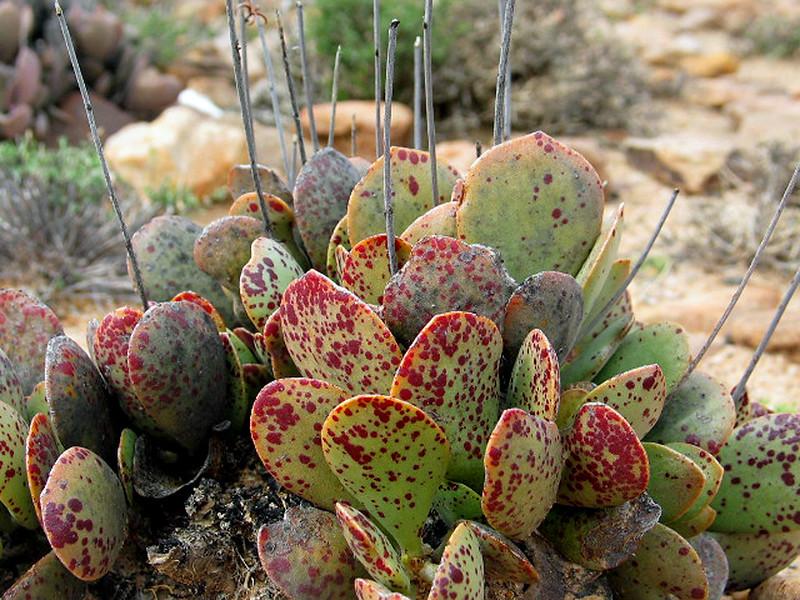
Adromischus alstonii
Adromischus maculatus (Calico Hearts)
Adromischus maculatus grows on the Langeberg sandstone mountains of South Africa. Another eye-catching plant with roan cheetah pattern leaves gets bright red. It slowly rises to 400 mm high. These succulent plants have a fibrous root system with tiny, prostrate woody 200 mm stems.
Leaves are wedge-shaped, ovate to rounded, and horny with brownish-red spots. But some young plants lack brown spots. Flowers are tubiform and yellow-green with pink or white 2 to 5 mm long corolla.
Best Place to Grow
These are hardy plants that are most suitable for succulent outdoor gardens. They need considerable amount of bright sunlight and form clusters.
Only plant indoors where there is enough bright light for its growth. But it rarely produces flowers inside. Besides, these red succulents are not edible and can be harmful to humans and animals.
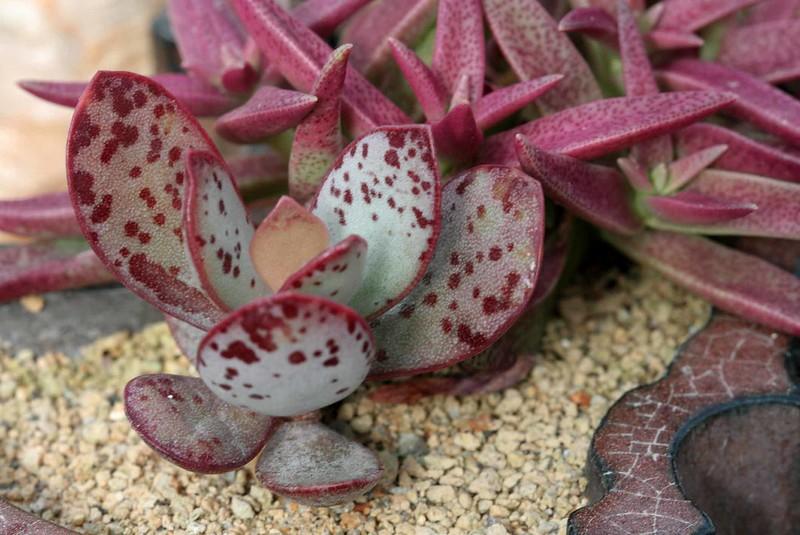
Adromischus maculatus
RELATED: How to Get Rid of Mold on Succulents: A Comprehensive Guide
Adromischus marianae
These red succulents are indigenous to South Africa (Namibia). It thrives in the cracks of rocks and under the shadow of shrubby plants.
These are cute, short, less branched, and slow-growing plants. They have horseshoe-like margins and are about 16 cm tall.
Adromischus marianae produces rough leaves in clusters that may be reddish-brown or green. Leaves may be ovate or tapered with brown marks up to 8 cm long. They produce 1.5 cm long and pink-tinged green flowers in early spring.
Best Place to Grow
It is an ideal indoor plant but requires full sun so keep it in places receiving the greatest bright light. Only grow outdoors when Adromischus marianae is frost-protected, and conditions are favorable for its growth.
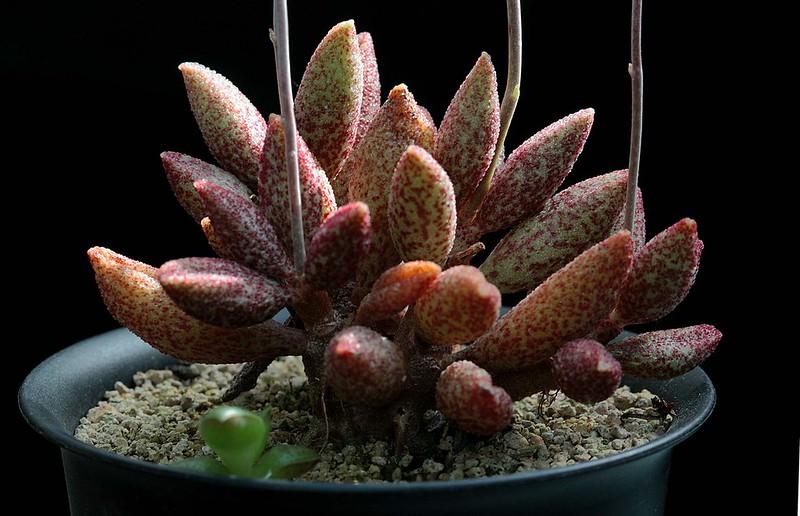
Adromischus marianae
Aeonium decorum (Green Pinwheel)
Aeonium decorum belongs to the Canary Islands. It is a small, spherical, much-branched, and evergreen plant that reaches the height of 50 to 60 cm.
This plant produces deep green foliage with red outlines in a small rosette style. Leaves can grow to 6 cm high and 2 cm wide, and flowers are star-like, showy, small, and whitish to bright red.
Best Place to Grow
Aeonium decorum is a winter or spring plant and is excellent for indoor floral gardens. These red succulents need daily watering that is quite different from other succulents. But it becomes inert in scorching weather and does not need excess water. They also thrive best in almost all types of outdoor gardens.
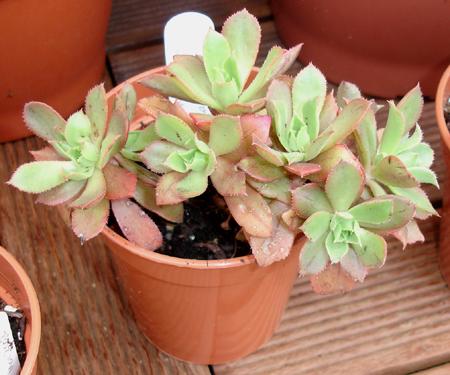
Aeonium decorum
Aloe cameronii
Aloe cameronii is a vibrant evergreen plant that belongs to the African continent. These slow-growing red succulents are 50 to 60 cm tall.
It forms straight rosette stems and deep burgundy to green leaves that are pulpy starfish blade-like leaves. These lovely Aloe species produce red-peachy flowers above the leaves.
Best Place to Grow
This plant grows best in full sunlight in gravel, rocky, and succulent gardens. They propagate in big containers and gallons indoors. They attract birds by producing nectar but maybe harmful to animals.
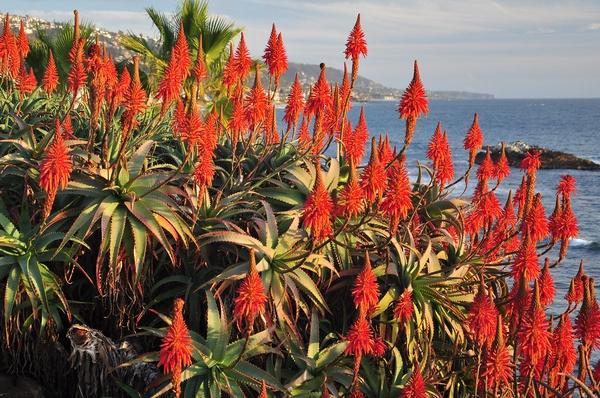
Aloe cameronii
Aloe Crosby‘s Prolific
This evergreen Aloe species grows without stems in countries having all three kinds of weather summer, winter, and spring.
It can grow to 10 to 40 cm high and produces juicy, spear-shaped, deep green leaves that turn red in full sun. Leaves have semi-transparent teeth that cover the leaf outlines, 40 cm long and tubiform flowers are showy and orange in color.
Best Place to Grow
Aloe Crosby’s Prolific thrives indoors only when there is enough warmth. However, sunlight-facing window sills or shelves are best for its growth. It is also perfect for outdoor gardens and requires full sunlight 6-7 hours per day.
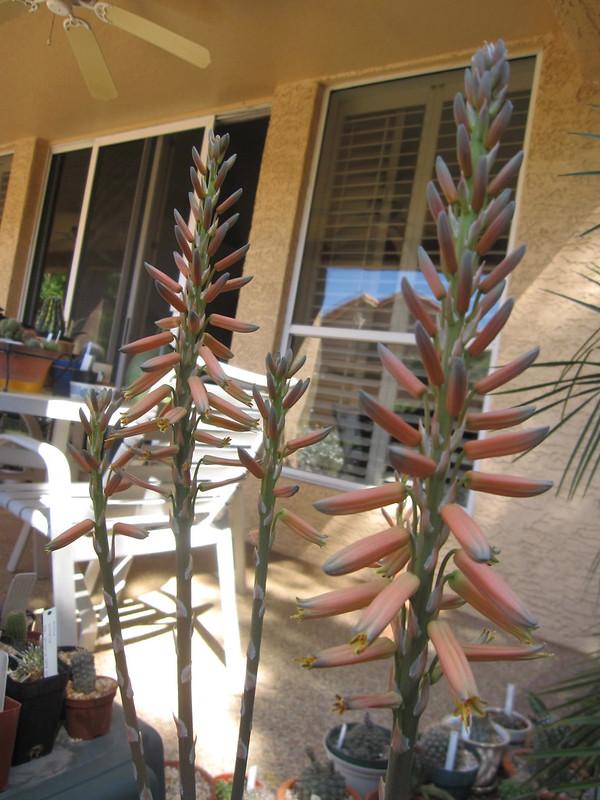
Aloe Crosby’s prolific
Callisia navicularis
Other names of this plant are Chain Plant or Tradescantia navicularis. This red succulent belongs to Mexico.
These are annual ornamental succulents consisting of pyramidal light green leaves. But leaves turn red, purple, and pink if placed in direct sunlight for a long time. They produce triangular purple flowers that comprise three petals.
Best Place to Grow
It’s best to place the Callisia navicularis on east-west sunlight-facing windows. Thus it would be a fantastic addition to a container garden. But it’s necessary to make this red succulent frost-resistant first if you plan to grow it outdoors.
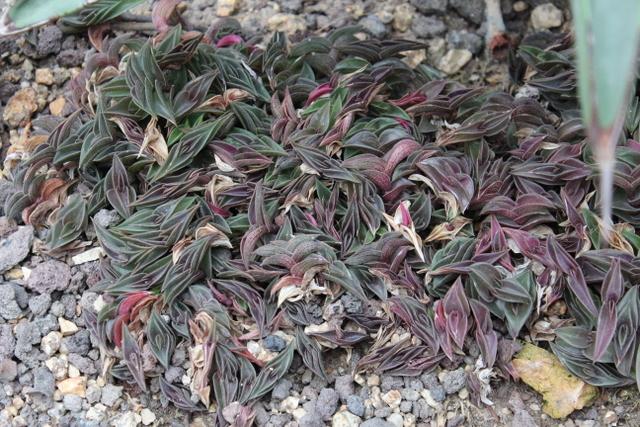
Callisia navicularis
Callisia repens (Pink Creeping Plant)
This red succulent grows in Australia, Central-South America, and the West Indies. Callisia repens are fantastic accent plants that thrive fast in tropical forests.
They can achieve a height of 10 to 11 cm or more. This plant body consists of delicate, stripped and round leaves. These leaves are pink to off-white with central green stripes. Flowers are small-sized and white.
Best Place to Grow
This creeping plant is most suitable for indoor hanging baskets. It also grows happily in the rock, gravel, and cottage gardens in the blooming season.

Callisia repens
Crassula capitella (Red Pagoda)
Crassula capitella originates from South Africa and is a fantastic featured succulent. This jade plant forms an upright pagoda tower with pyramidal bunchy scarlet leaves.
These colorful succulents are 20 cm tall and appear as runners or colonial forms in early summer. Leaves become bright orange to deep burgundy when receiving direct sunlight. This succulent provides a fiery dramatic view.
Best Place to Grow
This Crassula species propagates in gravel or Mediterranean gardens. They are also perfect for containers and indoor hanging ornamentals.

Crassula capitella
RELATED: Are Succulents Really Toxic and May Hurt Your Innocent Cat or Dog?
Crassula pellucida ( Calico Kitten)
Crassula pellucida is an African plant species comprising tiny heart-shaped, oval leaves. The plant leaves are lime green with pinkish-red edges. They bloom in spring or early summer, and the white flowers with leaves surround the stems.
Best Place to Grow
A unique feature of this plant is that it can grow anywhere, but it requires much warmth for breeding. It is advisable to plant this species outdoors in spring and keep them indoors in winter.
Full afternoon sunlight may burn this plant in summer. So to overcome this risk, only move these plants outdoors in the morning.
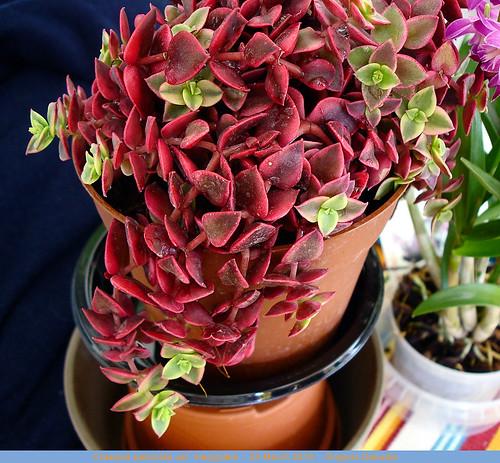
Crassula pellucida
Dudleya stolonifera
Dudleya stolonifera is an endemic succulent species that grows on the hanging cliffs of California, Orange Country, and Laguna beach.
This plant shows uniqueness so that it arises from the lateral unbranched stem and produces secondary vegetative stems. Lateral and aerial branches with 10 to 12 cm fresh green elliptical leaves. Edges of the leaves show a deep burgundy coloration and appear from the 2cm wooden base. It produces light yellow to green flowers.
Best Place to Grow
This plant propagates with other plants like lichens and bryophytes on the ridges of hanging rocks. ECOS listed Dudleya stolonifera as an endangered species. NCCP and NEPA are working on conservatory plans to recover this rare succulent.
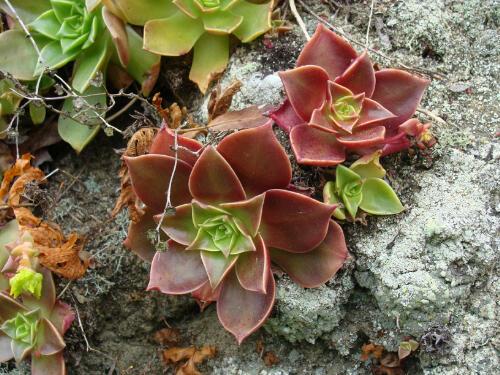
Dudleya stolonifera
Echeveria agavoides ( Romeo)
A distinct feature of this plant is the aesthetic rosette forms that make it outstanding. Echeveria belongs to North America.
This plant gets its common name, “Lipstick,” due to its red-edged leaves. It can grow up to 16 cm high and 40 cm wide, and leaves are green, elongated with bright red edges. This plant produces small red showy flowers in the spring.
Best Place to Grow
Like other succulents, Echeveria agavoides can breed both outdoors and indoors.Rosette and cute forms allow you to grow these succulents in pots, containers and succulent gardens.

Echeveria agavoides ( Romeo)
Echeveria pulvinata (Ruby)
This Echeveria species originates from South and North America. It can distract anyone due to its dramatic and dazzling morphology. The plant reaches a height of up to 15 cm. The main feature of all Echeveria species is their adorable colorful fleshy leaves.
Leaves have translucent hairs that prevent excessive evaporation. This plant is long-living and produces leaves and flowers many times a year. Leaves are green from the center, along with bright red corners. Flowers are bell-like orange to red.
Best Place to Grow
Echeveria pulvinata is not poisonous and is one of the best indoor and outdoor rosette ornamentals. This plant is sunlight-loving and thrives well in a warm climate. But it is not frost-resistant, therefore, keep them inside in cold weather and use containers or pots to grow them. Place Echeveria pots near east or west-facing windows.
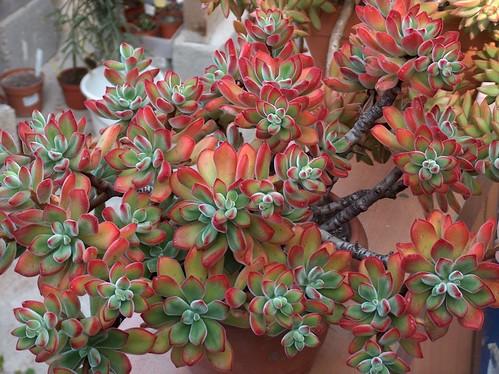
Echeveria pulvinata (Ruby)
Euphorbia trigona (Royal Red)
Euphorbia trigona is a common evergreen succulent plant of Central Africa. Stems consist of thick three wing-like branches, leaves and short pointed spines. Leaves appear to grow in the midpoint of two orange-red spines that are about 5 to 6 mm long.
The sharp spines of this Euphorbia species contain poisonous latex that can cause skin and eye irritation if they come in physical contact. It gets the nickname “Royal Red’ because of its plum to red flowers
Best Place to Grow
Euphorbia trigona is an outdoor plant and propagates well by regular trimming, it’s better to use gloves while cutting random branches. Royal red is perfect for creating hedges in outdoor gardens. Yet, it is not safe to grow this plant indoors because of its poisonous spines.
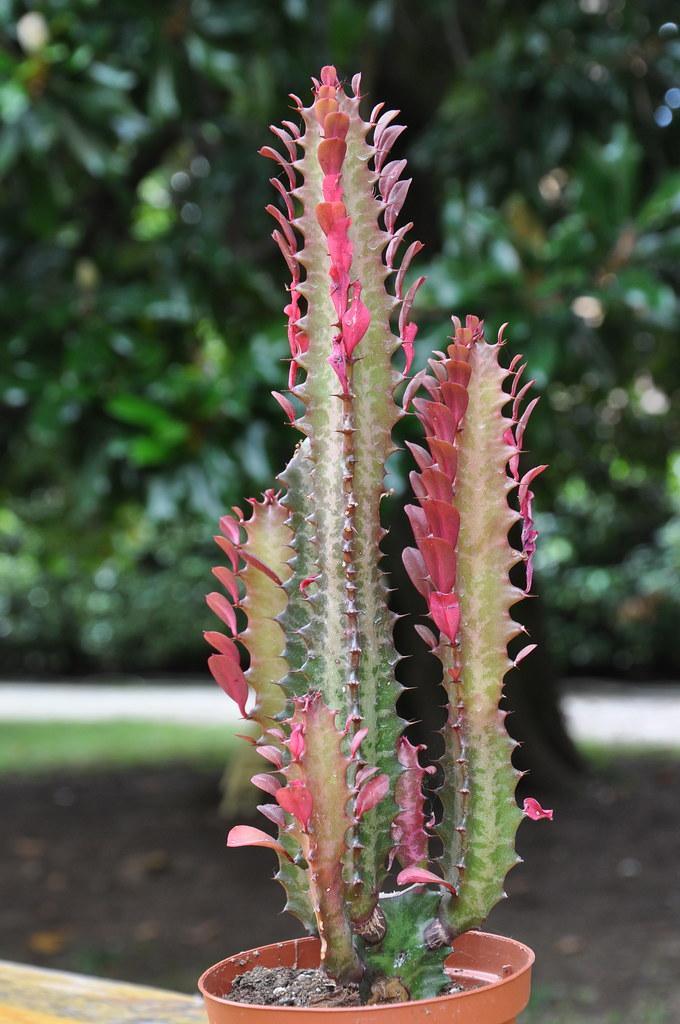
Euphorbia trigona
Graptopetalum superbum
This cute flowery succulent originates from Mexico. This plant forms rosettes of large purplish grey leaves on robust stems.
Rosettes are planate, open and can reach up to 6 inches in diameter. Graptopetalum superbum is a low spreading and bloom best in full sun, and turns to maroon or red. Star-like flowers are light yellow with red edges.
Best Place to Grow
This plant is ideal for creating floral ground covers in rock, Mediterranean and gravel gardens. It can grow in containers, pots and hanging baskets.
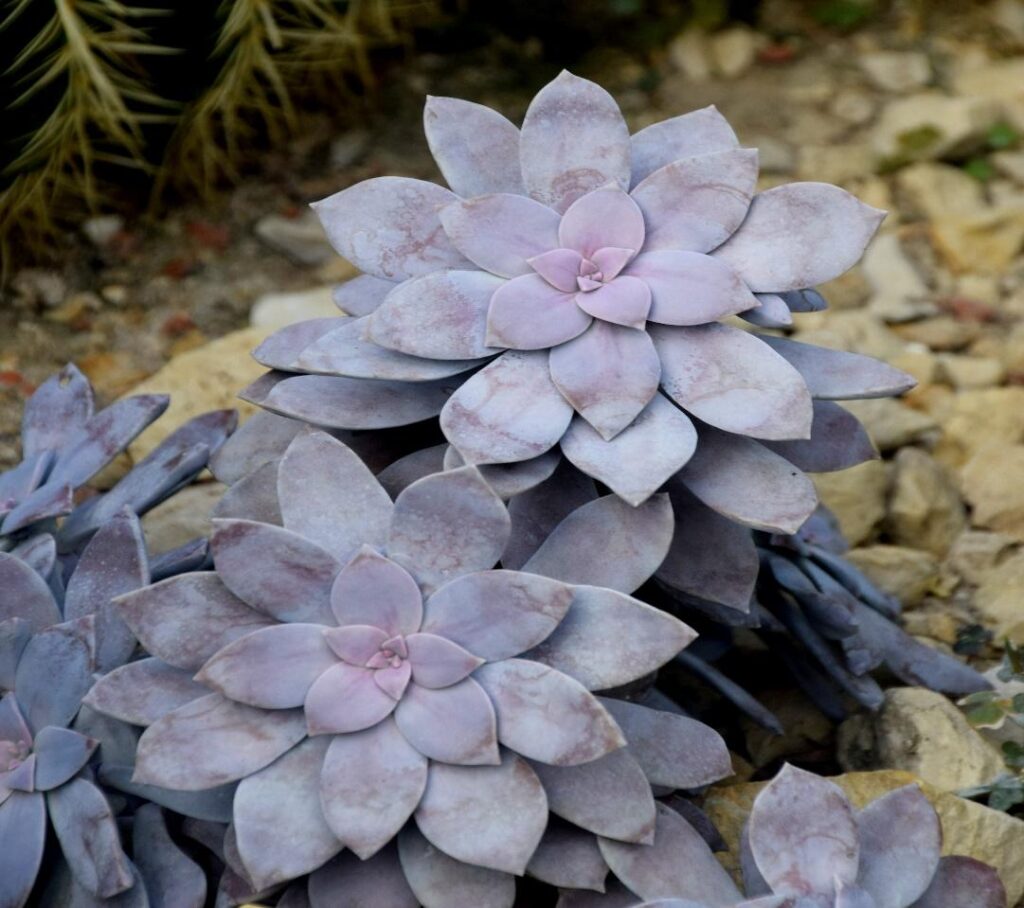
Graptopetalum superbum
Hylotelephium sieboldii (Japanese Stonecrop)
The common name of this plant is Sedum sielboldii. Several strains of this plant originate from China, Japan, and Shodoshima islands.
It’s a slow-growing temperate succulent that comprises 30 to 35 cm trailing stems. Showy whorled round leaves are fleshy, bluish-green, and with deep red tips are 2 to 3 cm in diameter. These succulents produce leaves in three whorls and flowers may be purple, golden or pink.
Best Place to Grow
Hylotelephium sieboldii is an edible succulent, but some varieties can be poisonous to humans and castles. It is a perfect specimen succulent for children’s parks, rockeries, and greenhouses. This plant grows in hanging baskets and is well-suitable for containers.
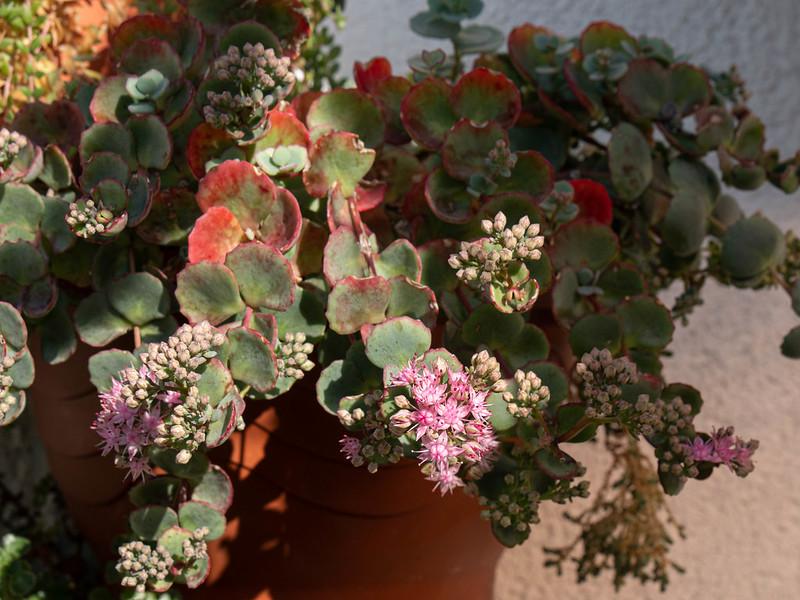
Hylotelephium sieboldii
Kalanchoe luciae (Paddle Plant)
This distinct plant is common in eastern and Southern Africa. This succulent plant grabs much attention due to its paddle-shaped large foliage. Kalanchoe luciae grows up to 60 cm high consisting of spherical green leaves with red edges. Whitish-yellow blooms safeguard the sunlight-facing leaves from sunburn.
Best Place to Grow
They are ideal for coastal gardens, rock and gravel gardens. Kalanchoe luciae gets bright red colors when exposed to full to partial sunlight. These plants are also best for indoor potting and can be an ideal ornamental partner.
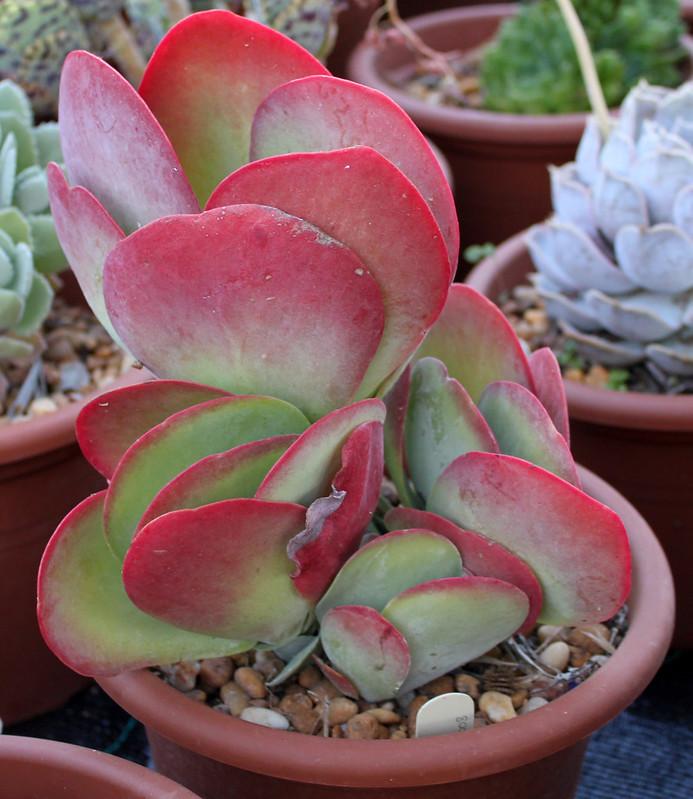
Kalanchoe luciae
Kalanchoe tomentosa (Panda Plant)
This red succulent species belongs to Madagascar that resembles the cat’s ears. This plant grows up to 60 cm high depending on the pot size. It has a fleshy stem, rosette ovate leaves, many branches.
Leaves are grey to green with reddish-brown spots on the edges. Thin brown hairs cover the leaves and make them velvety soft. They produce tube-shaped flowers only when exposed to full sunlight but rarely bloom indoors.
Best Place to Grow
Panda plants can be a part of indoor hanging plants that breed well in containers or small pots near south or east-facing windows. Plant these red succulents outdoors only when receiving morning sunlight for a long time. But protect them from scorching intense heat that can harm them.
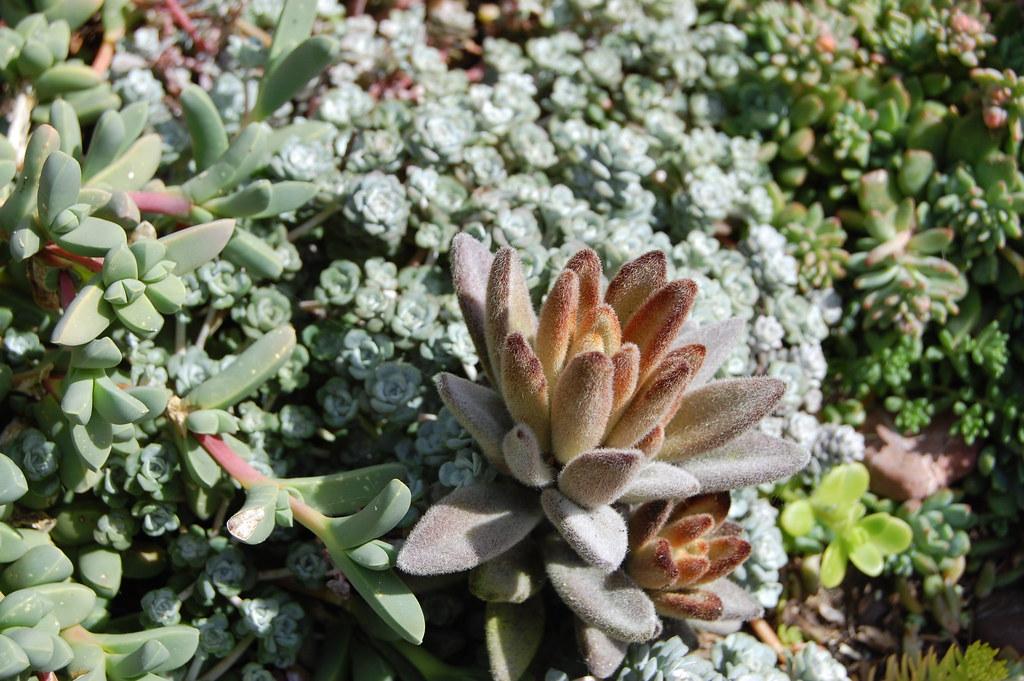
Kalanchoe tomentosa
Lenophyllum guttatum
Lenophyllum guttatum is a Mexican perennial succulent that grows in the cracks of rocks. The plant body attains a height of 15 to 20 cm consisting of much-branched, delicate aerial stems.
Leaves are greyish green and funnel-shaped with brown or black spots. Leaves are 3 to 4 cm in length produced on flowerless stems. They induce clusters of small 4 to 11 greenish-yellow flowers on tubular pink stalks. Fruits have brown seeds in brownish sacs.
Best Place to Grow
Lenophytum guttatum is most suitable for deserted gardens in warm climatic regions. This red species is also best for indoor planting.
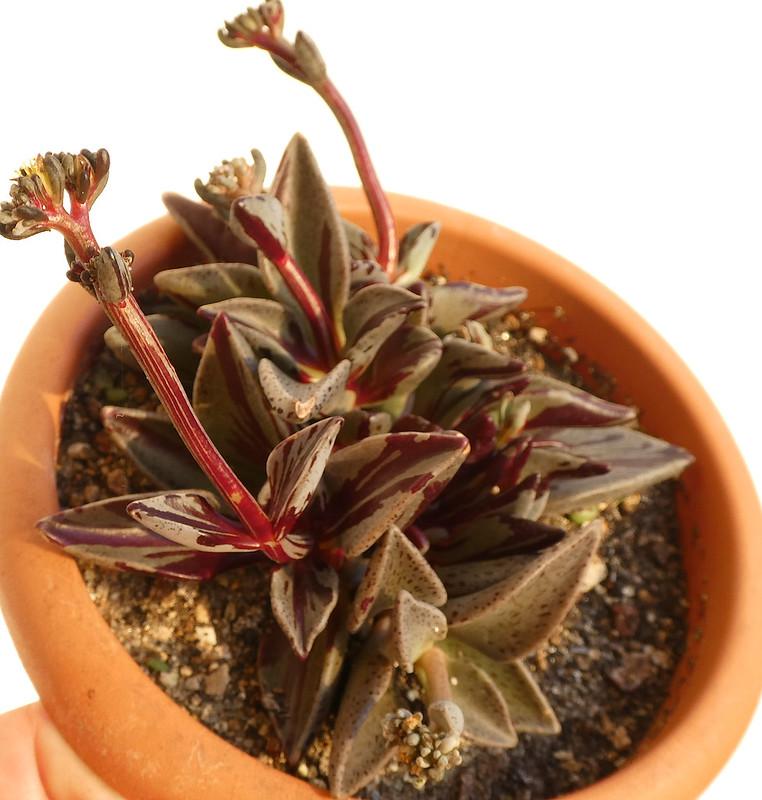
Lenophyllum guttatum
Mammillaria spinosissima
Mammillaria spinosissima grows in the deserts of Central America and Mexico, but it will be extinct in Mexico regions. This plant has a rounded deep blue-green stem covered by yellow or rusty brown sharp spines.
Stems are 30 to 35 cm high and 10 to 12 cm wide in diameter. Purplish pink flowers are cone-shaped and reach 1 to 2 cm tall and 1 to 1.5 cm wide in diameter.
Best Place to Grow
Mammillaria spinosissima is safe for humans and animals. They will thrive in containers and big pots indoors and outdoors. Thus, It is better to expose this red succulent to full sun on its remarkable growth.
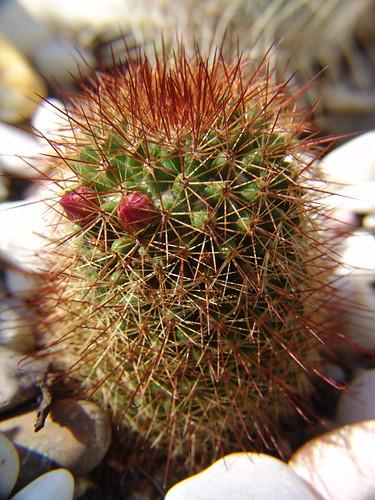
Mammillaria spinosissima
Orostachys japonica (Rock Pine)
Orostachys japonica grows on hills of East Asian countries like Korea, China, Japan. It’s a short-lived biennial or perennial succulent plant. It forms 1 to 2 cm high and 7 to 9 cm wide, dense clumps of leafy rosettes. Greyish-green leaves are 7 to 8 cm long and 1 to 2 cm wide in diameter.
These green leaves turn red; flowers with five petals are small, cone-shaped, and white. This plant is of great medical importance and treats many disorders like cancer, Periodontal disease, and inflammation of the uterus.
Best Place to Grow
This plant loves partial or full sun and thrives both indoors and outdoors.

Orostachys japonica
Peperomia graveolens (Ruby Radiator Plant)
The popular name of Peperomia graveolens is a ruby glow radiator plant. This plant is low growing and propagates in Ecuador and Peru and reaches the height of 22 to 25 cm.
It consists of deep red fleshy leaves and stems, but leaf tops are translucent and spear-shaped. Flower cymes appear as a pale green powder 8 cm high and produce small white and yellow flowers.
Best Place to Grow
Ruby glow radiator is a favorite table and succulent desk plant and is a perfectly natural plant for decorative purposes. This plant is safe for kids and pets and grows in pots and containers. Also, Plant these succulents in partial or full sunlight.
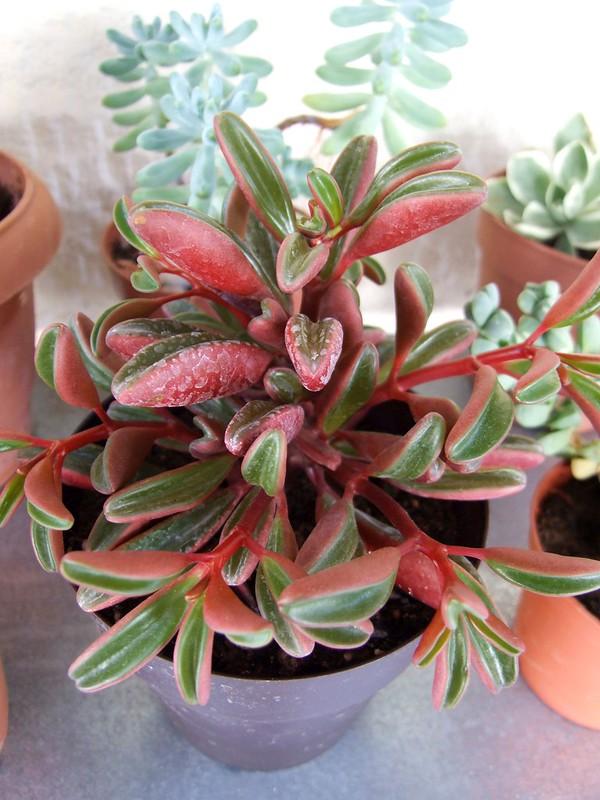
Peperomia graveolens
Peperomia caperata (schumi Red)
Peperomia caperata grows as ground cover in the tropical forests of Brazil. This red succulent has creeping stems with a rosette of green leaves that get glossy red at maturity.
Heart-shaped ridged leaves with deep green veins and red stalks show unique characteristics. Leaf length can be 2 to 3 inches, and the whole plant reaches 25 cm high. They only bloom in winter or spring and produce white fade flowers.
Best Place to Grow
This plant is shade-loving succulent and prefers low light to reproduce. Peperomia caperata is a popular houseplant. Plant them outdoors only if the living areas are not very hot.
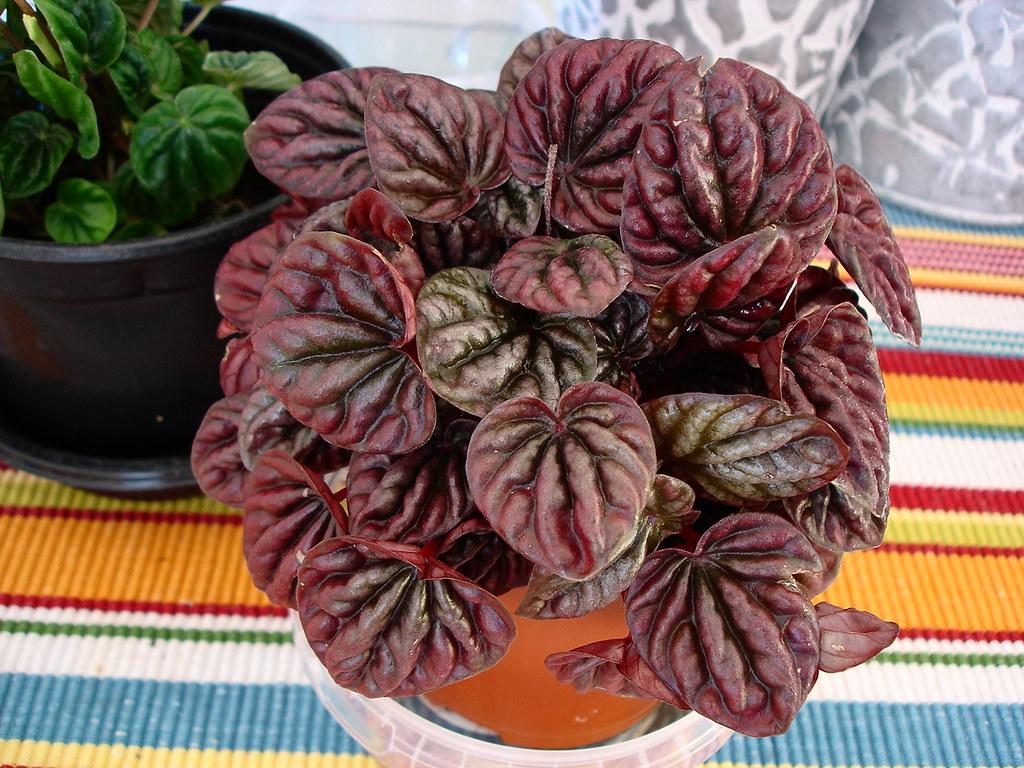
Peperomia schumi Red
Sedum rubrotinctum ‘Aurora’ (Pink Jelly Beans)
Sedum rubrotinctum originates from Mexico and is an attractive low-growing red succulent. The whole plant provides jelly beans like feel that are inedible and can cause problems such as skin irritation. It can be 15 to 17 cm tall and 80 to 90 cm wide, stems are creeping, and 26 cm long. Stems consist of green jelly beans like leaves with vibrant red-toned tips. They produce tiny, starlike yellow flowers with stalks.
Best Place to Grow
As mentioned in the above description of Sedum Aurora, it is not safe for humans and pets. Always keep them indoors where any type of physical contact is not possible. It can be a fantastic ground cover and is well-suited for rock and gravel gardens.
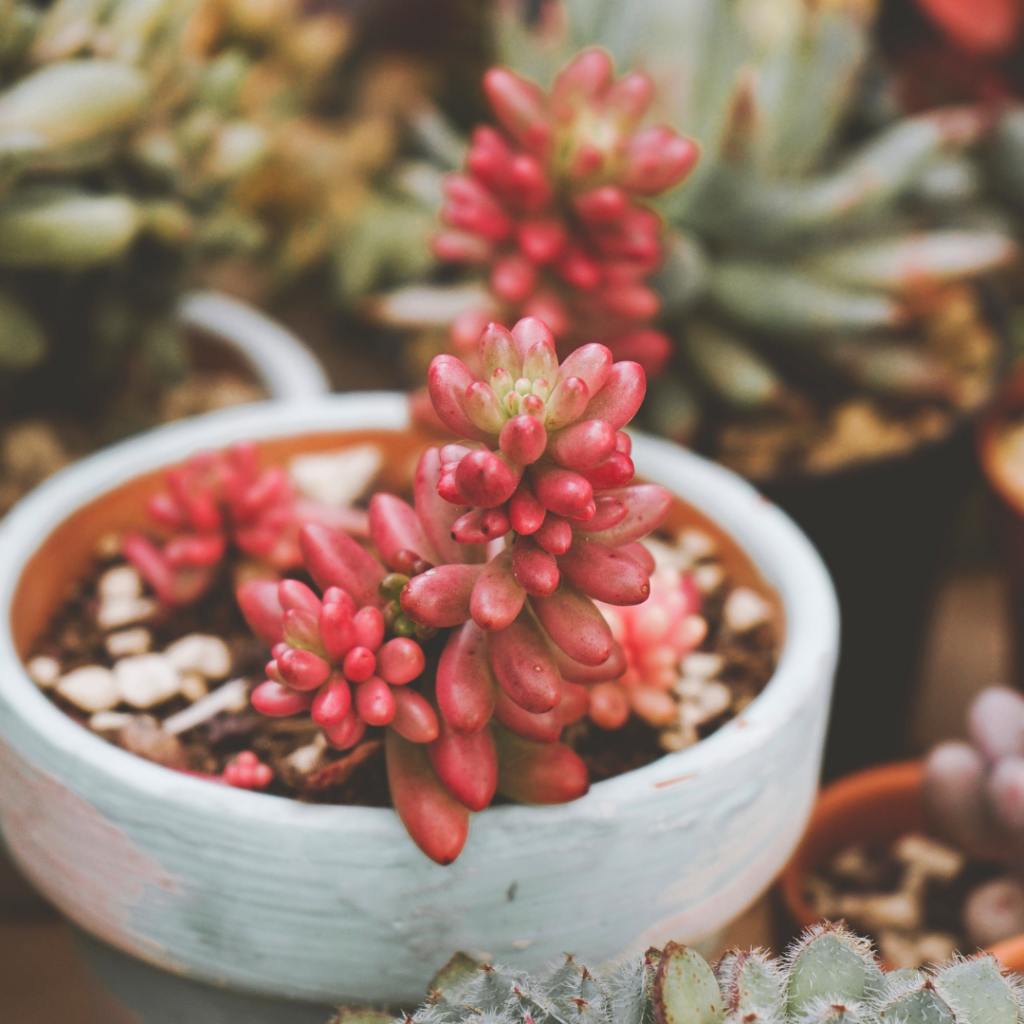
Sedum aurora
Sedum spurium (Stonecrop)
These Sedum species belong to Asia and Europe. Indigenous people call it “Stonecrop” because of its leaf arrangement in two rows on stems. Plants grow slowly and reach 12 to 15 cm and 40 to 46 cm wide in diameter. Sedum spurium covers the floor with green mats creating lush floral greenery.
Stems are creeping much-branched that carry rows of a green oval to round leaves. Tips of the leaves are fresh red and these leaves look needlelike at bases. Bunches of small red flowers with rows of fleshy leaves is the perfect idea to design free spaces.
Best Place to Grow
Sedum spurium has spreading nature and is a lovely large succulent like Euphorbia and Cacti. This plant is most suitable for rocky and pallet gardens. These plants love hanging baskets and containers with adequate light for indoor planting.

Sedum spurium
Sedum stahlii (Mexican Sedum)
Sedum stahlii originates from America but commonly grows in Mexico. This plant shows slow growth, perennial nature forming 26 cm high and 25 to 30 cm wide stunning ground cover. Deep red pulpy ovate leaves with green veins are 1.5 cm long and appear on creeping stems. Leaves of Sedum stahlii are very sensitive and deciduous. Flowers are 1.5 cm wide, stellate, and light yellow.
Best Place to Grow
Sedum stahlii is a hardy plant that propagates with little care anywhere. This succulent loves partial to full sun and grows in alpine and succulent gardens. It gives a natural fruity touch and look terrific when growing in pots and containers.
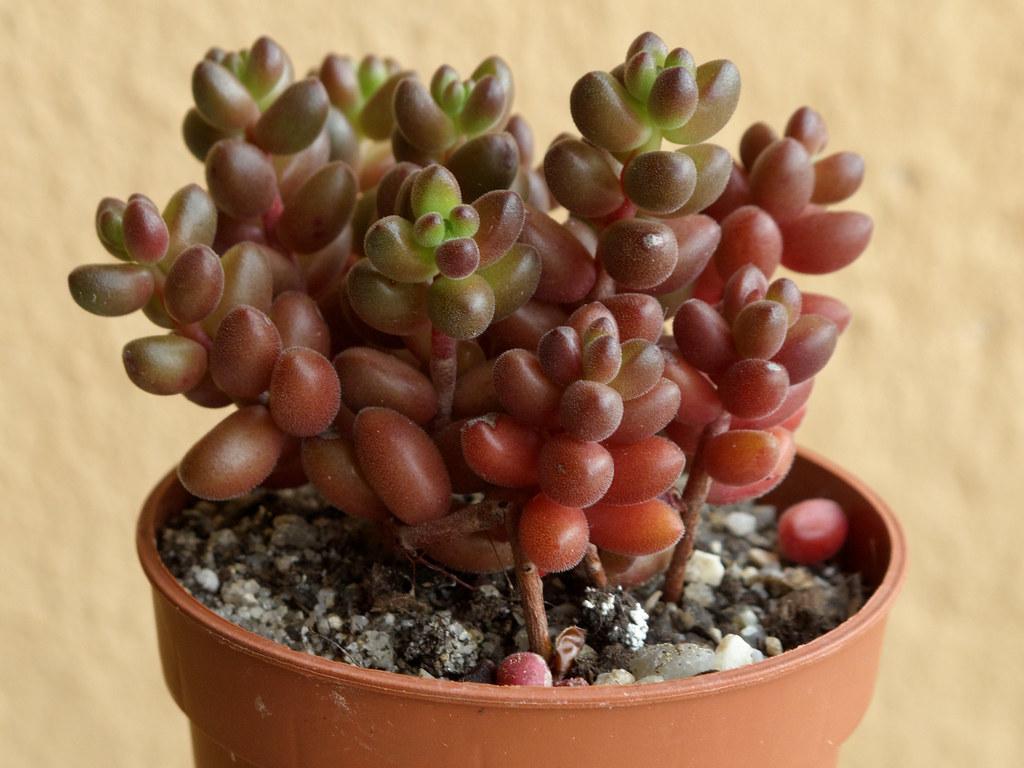
Sedum stahlii
Sempervivum heuffelii (Chocolate Sundae)
It may be difficult to find this plant in garden shops and nurseries but naturally grow on the mountains of Northern America and Europe. It commonly refers to “Hens and Chicks” because the baby plants emerge from the parent rosette. Sempervivum heuffelii chocolate sundae shows unique characteristics.
This lovely plant sustains its bold red, green, magenta and blue coloration the whole year. 2-4 stunning rosettes can be 10 to 12 cm in diameter, and they spread in rounded colonial mats. Leaves of chocolate sundae look glossy due to white cilia hairs at their edges. Pale yellow and upright flowers grow with up to 20 cm long stalks. Unlike other succulents, whether it is cold or intense heat, this succulent can withstand any type of harsh weather.
Best Place to Grow
No need to worry about sunburn and frost. Now enjoy gardening with the rosette clumps of Sempervivum heuffelii chocolate sundae. It is a perfect choice for succulent outdoor gardens. Always use gallons or large containers and hanging baskets to introduce creativity with this plant indoors.
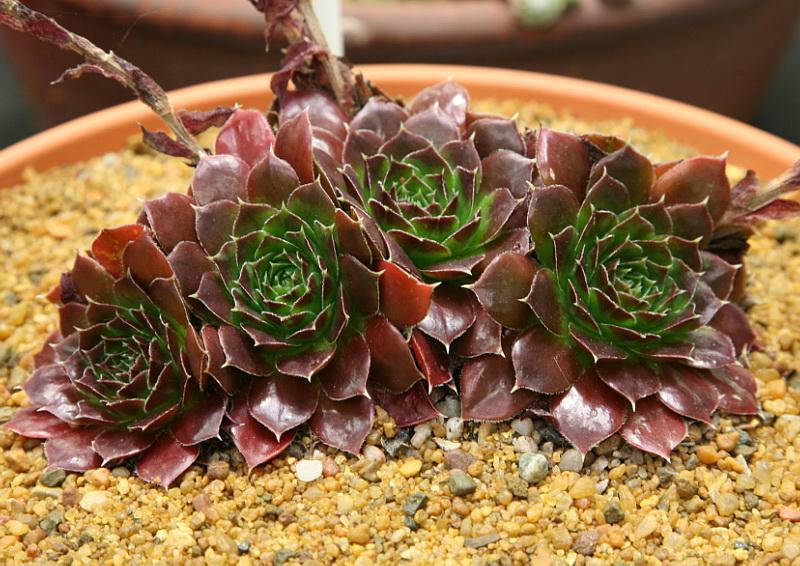
Sempervivum heuffelii
Sempervivum tectorum (Houseleek)
This evergreen plant thrives on the hills of South Europe. It forms ground cover by spreading the horizontal colonies of baby rosettes. The whole plant grows 4 to 6 inches high and 15 to 20 inches wide and wither after producing the baby rosettes.
1 to 4 inches Greyish-green clusters of leaves with red tips surround the aerial and hairy stems. Sepervivum tectorium shows reddish-purple flowers in spring or summer. According to ancient Roman tradition, this red succulent is a miracle plant and safeguards houses from lightning disasters.
Best Place to Grow
This species is suitable for both rock gardens and container plants. Like other mats or ground-forming succulents, it can cover spacious spaces with elegant-looking glossy leaves.
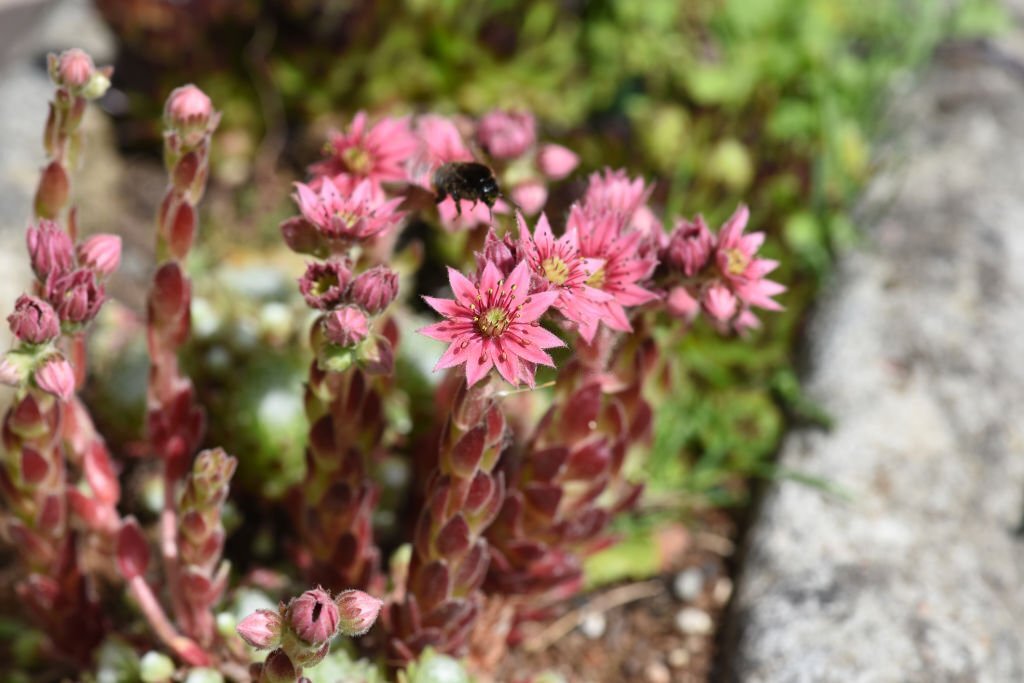
Sempervivum tectorum
Tradescantia spathacea (Oyster Plant)
Like other red succulents, rosettes of Tradescantia spathacea grow in Louisiana, Mexico, Florida. This perennial species occupies large tropical regions and can be 1-foot-high and 2-3 inches wide in diameter. Tiny and solid stems carry 5 to 6 inches’ spear-shaped, rough and ugh evergreen leaves. These plants fill the free spaces with deep green foliage purple-red from the center. The star-like flowers are white about 0.5 to 1 inches and bear purplish yacht form sepals.
Best Place to Grow
It is easy to grow in pots and containers, but ASPCA warns about its toxicity. This plant can be a skin and eyes irritant if touched and is unsafe for humans and pets. But, it is wild and happily thrives in a natural habitat like succulent outdoor gardens.
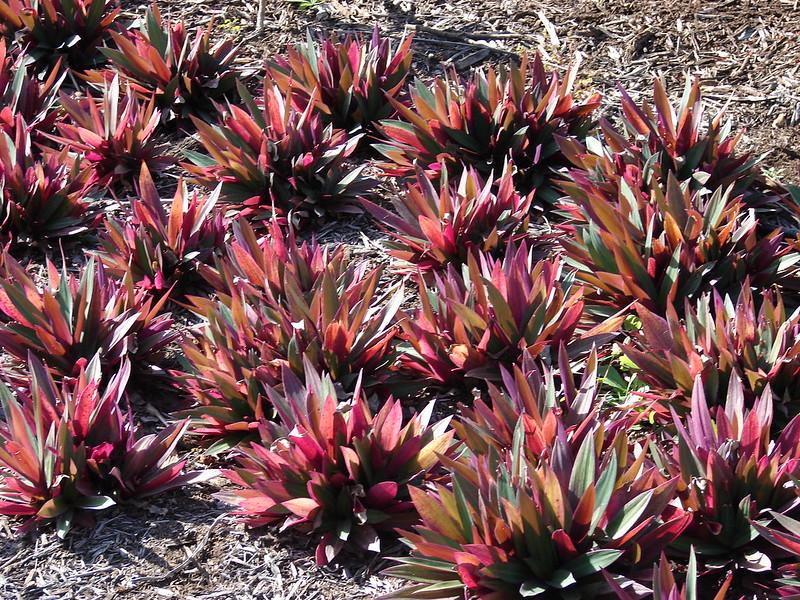
Tradescantia spathacea
Umbilicus oppositifolius (Lamb’s Tail)
Umbilicus oppositifolius belongs to the Caucasus and grows to 16 to 22 cm high and 16 cm wide in diameter. This evergreen procumbent red succulent forms transparent, dazzling ground cover in shaded places. Stems are reddish-brown, sinking, while leaves are oval, branched and yellowish-green. These plants produce 18 to 20 cm of fresh yellow flowers in the spring and summer.
Best Place to Grow
This Umbilicus species are shade-loving and thrive best in city gardens and gravel gardens. Only grow under shade or partial sunlight outdoors.
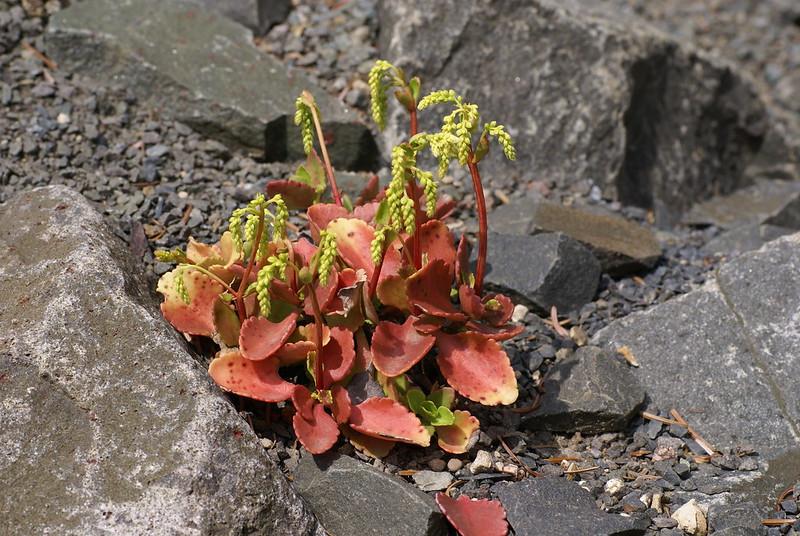
Umbilicus oppositifolius
FAQs:
What is the red succulent commonly called?
They are also called “Red Pancakes” because of the famous red succulents, the Kalanchoe thyrsiflora and the Kalanchoe luciae. The Kalanchoe plant has paddle-like broad leaves that give the appearance of pancakes. Kalanchoe overlapping green leaves get red in very hot or cold weather.
How do I convert my succulents to red?
If you buy red succulent plants for your gardens and turn green, don’t worry. It’s easy to redo them red. All you need to do is place the green succulents in full sunlight. Then, repeat this process for 5 to 7 hours a day until they become stressed and red.
Are there any red succulents?
Red succulents are everywhere, but you might not notice yet. The surprising story behind this is that green succulents are vibrant red succulents. Green succulents turn red due to extreme weather or unsuitable factors like poor soils and lack of moisture (wilting).
How to take care of a Kalanchoe plant?
Kalanchoe plant requires some preventive measures for good growth:
- Grow Kalanchoe plants in places that receive enough amount of sunlight
- Always grow this plant in Humus rich soils like loamy and sandy soils
- Follow the wet and dry methods for watering the Kalanchoe plant.
- Fertilize the Kalanchoe after every two weeks during growth.
- Temperature below 40 degrees Fahrenheit is harmful and causes plant death within a few hours.
Editor’s Recommendations
Learn how to make the best succulent soil mix, check out Step by Step Guide to Preparing a Perfect Potting Mix for Your Succulents
Do Succulents Attract Bugs? Plus Best Home Remedies on How to Prevent Them?







